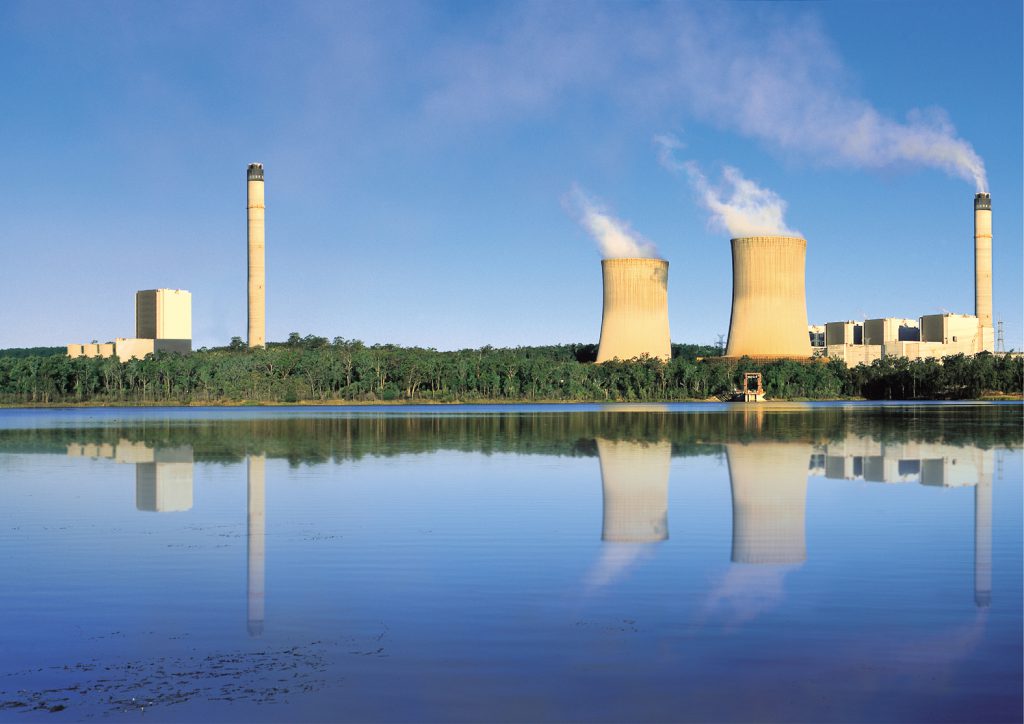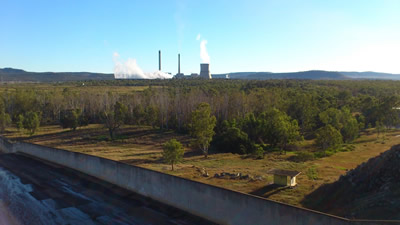Boyne River and Tarong
Scheme


Scheme information
About
The Boyne River and Tarong Scheme draws water from Boondooma Dam and supports Tarong Power Station and irrigators along the Boyne River.
How the scheme works
- Boondooma Dam is fed by the Stuart and Boyne River
- The scheme includes three pump stations and three balance storages across 95km of pipeline
- Water from the dam is released to supplement natural flow in the lower Boyne River.
Water uses
- Irrigation water from the Boondooma Dam is released to supplement natural flow in the lower Boyne River
- Industrial water used for cooling at Tarong Power station.
Major storage
Boondooma Dam
Boondooma Dam was built in 1982. The dam is fed by the Stuart and Boyne River.
Channel/pipeline system
The Tarong Pipeline was completed in 1983, approximately two years before the opening of Tarong Power Station. It incorporates three pumping stations – Boondooma, Melrose and Ellwoods Road – and three balancing storages – Melrose, Ellwoods Road and Goodger. The Tarong Pipeline draws its water from the Boondooma Dam. Water is pumped from Boondooma Dam via three pump stations along the 95 kilometre route.
Supply of water along the Boondooma-Tarong Pipeline is essential to maintain operation of the Tarong Power Station. Water is used by Tarong Power Station for cooling purposes.
Scheme Management
Sunwater must comply with the conditions set out in the Boyne River and Tarong Water Supply Scheme Resource Operations Licence (ROL), issued to Sunwater in December 2006 by the Department of Regional Development, Manufacturing and Water (DRDMW). The ROL outlines the infrastructure details, environmental release rules and all Sunwater’s monitoring and reporting obligations. The ROL also requires Sunwater to operate in accordance with an operations manual that is approved by DRDMW. The operations manual outlines rules for the operation of infrastructure associated with the Boyne River and Tarong scheme as well as water sharing rules and seasonal water assignment (temporary trade) rules.
The Boyne River & Tarong Water Supply Scheme ROL Operations Manual was issued in February 2020. An amendment to correct administrative and typographical errors was approved by the Department of Regional Development, Manufacturing and Water on 27 November 2020. A statement of changes to the operations manual can be found on the second page of this manual.
Sunwater focuses our resources towards timely and cost-efficient delivery of water to customers in the Boyne River and Tarong scheme. We collaborate with our customers to ensure we understand their needs, adapt quickly to changes in the environment and make the most of the available water supply. To best manage water delivery, arrangements for taking of water within the Scheme have been developed in consultation with its Irrigator Advisory Committee.
Taking water from the scheme
The water ordering system assists Sunwater in delivering water to its customers in an efficient and timely way, enabling them to plan and manage their water use.
Before taking any water, customers should place a water order so that Sunwater can release sufficient water and minimise losses.
Customers who take water without ordering may reduce Sunwater’s ability to supply customers who have ordered according to the above requirements.
To place an order
Customers can place their orders via:
- Sunwater Online.
- Sunwater Customer Support on 13 15 89
Further information about ordering water is detailed in Boyne River and Tarong’s Rules and Targets.
Stopping or restricting supply
Sunwater may suspend or restrict supply in a number of circumstances, including:
- during maintenance of Sunwater’s assets
- during a peak demand period, when rosters or rations may apply
- when the demand for water is so small it is impractical to supply it
- when there is a need to make special releases to maximise efficiency at times of limited supply
- during rain shutdown
- infrastructure limitations which make delivery impractical
- if supply could cause Sunwater to break the law
- when operating under special notices or regulations issued by the Department of Natural Resources and Mines {e.g. Water Amendment Regulation (No.3) 2006}.
Weather events and emergency shutdowns
Sunwater asks that customers notify their duty Water Officer, as soon as possible, of any rain event or other circumstances that substantially lessens their water requirements. When widespread general rain exceeds 40 mm in a day over the Boyne River and Tarong Water Supply Scheme, the duty Water Officer may shut the system down.
Customers are also asked to cancel orders if they no longer require ordered water.
If you experience an equipment or power failure emergency, please give immediate notice to Sunwater by calling Sunwater Customer Support on 131589 24 hours a day, 7 days a week.
Boyne River and Tarong’s Irrigator Advisory Committee
The Boyne River and Tarong Irrigator Advisory Committee is a group of irrigators within the scheme that have been elected by irrigation customers to represent their interests in relation to scheme operations and water supply issues and improvements with Sunwater.
The committee:
- provides advice and recommendations to Sunwater regarding scheme operational issues
- represents the interests of the broader irrigator base in respect of Sunwater’s ongoing operation of the water supply scheme
- provides a mechanism for Sunwater and its customers to raise and discuss matters of mutual interest in relation to the management of the physical aspects of the scheme and customer relationship issues
- work collaboratively with Sunwater to identify and introduce new approaches and improvements to water management
Committee members
| Name | Position |
| Ken Darrow | Chairperson |
| Andrew Vicary | Committee Member |
| Troy Emmerton | Committee Member |
| Tim Allen | Committee Member |
| Ben Harzer | Committee |
| Boyd Paton | Committee Member |
| Stewart McKenzie | Committee Member |
| Link Davies | Committee Member |
Stay up to date with the Boyne River and Tarong Irrigator Advisory Committee.
Announced Allocations
Water Year: 2024/2025
High priority: 100%
Medium priority: 100%
Announced Allocations effective 1 July 2024 and will be applicable until revised and communicated by Sunwater.
Important message regarding water availability
In accordance with provisions of Section 8 of the Boyne River and Tarong Water Supply Scheme Operations Manual, Stage 1 of the critical water supply arrangements will be activated when Boondooma Dam is less than or equal to EL 268.7m AHD (approximately 70,000 ML).
If this rule is activated, access to Medium Priority allocation water will be suspended so the Announced Allocations are not guaranteed.
Details on the Critical Water Supply Arrangements can be found here.
Bed Sands
During critical water supply arrangements for medium priority customers, water can be taken from bed sands of the respective water courses. While bed sands water is accessible there is still an obligation to ensure the total volume of water taken in the relevant year (including both announced allocation water released from the dam and the bed sands water) must not exceed the water allocation holder's nominal volume. More information can be found here.
Customers are advised to obtain information about their remaining water allocation balance by accessing SunwaterOnline.
For more information or enquiries, phone 13 15 89 or email customersupport@sunwater.com.au.
History of Announced Allocations


















Operational reports
Sunwater releases periodic operational reports detailing Announced Allocation levels and individual storages’ breakdowns within each scheme, the latest of which can be found below.


























































































Service and Performance Plans
Sunwater prepares an annual Service and Performance Plan (S&PP) for each irrigation service contract area. S&PPs replace the former annual Network Service Plans and annual Performance Reports.
We have updated the naming convention for S&PPs to improve clarity and alignment with plan content. The new convention references the year in which the S&PP is published (or should have been published). Publication should occur within six months of the end of a financial year.
For further information about this service, please visit the Service and Performance Plan page.
Scheme news
















































































































































Scheme history

Boyne River and Tarong Water Supply Scheme
When the Queensland Government decided in 1978 to build a coal-fired electricity generation plant at Tarong near Nanango, the plans included the construction of the Boondooma Dam and a 95 km pipeline. The dam, built on the Boyne River near the town of Proston in the South Burnett region, was completed in 1982, and the pipeline linking it to Tarong was finished a year later.
Tarong power station is one of Queensland’s largest electricity plants. The first of its five generating units was switched on in 1985. Four more generating units have since been commissioned and all of them draw water from the scheme, mainly for cooling purposes. The scheme includes three pumping stations – Boondooma, Melrose and Ellwoods Road – and three balancing storages at Melrose, Ellwoods Road and Goodger.
The scheme supplies water to irrigators along the Boyne River who grow everything from mangoes, avocadoes, mandarins, grapes, pecans and blueberries to rearing cattle.
Barambah is an Aboriginal word meaning "a place where water ripples," with the scheme servicing the diverse farming region of South Burnett’s olive plantations, cattle grazing, pig production and crops including peanuts, lucerne, and cotton.
It is also the fastest-growing wine area in Queensland, with about 25 vineyards from small hobby plots to large commercial operations. Thriving on warm summer days, cool nights, fertile soils and reliable water, the South Burnett vineyards stretch from Goomeri in the north, through Murgon to the Bunya Mountains, Kingaroy and south to Nanango.

 MY ACCOUNT
MY ACCOUNT







